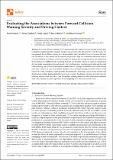Evaluating the Associations between Forward Collision Warning Severity and Driving Context
Author(s)
Seaman, Sean; Gershon, Pnina; Angell, Linda; Mehler, Bruce; Reimer, Bryan
Downloadsafety-08-00005.pdf (3.530Mb)
Publisher with Creative Commons License
Publisher with Creative Commons License
Creative Commons Attribution
Terms of use
Metadata
Show full item recordAbstract
Forward collision warning (FCW) systems typically employ forward sensing technologies to identify possible forward collisions and provide an alert to the driver in the event they have not recognized a threat. These systems have demonstrated safety benefits. However, because the base rate of collisions is low, sensitive FCW systems can provide a high rate of alarms in situations with no or low probability of collision, which may negatively impact driver responsiveness and satisfaction. We examined over 2000 naturally occurring FCWs in two modern vehicles as a part of a naturalistic driving study investigation into advanced vehicle technologies. Analysts used cabin and forward camera footage, as well as environmental characteristics, to judge the likelihood of a crash during each alert, which were used to model the likelihood of an alert representing a possible collision. Only nine FCWs were considered “crash possible and imminent”. Road-type, speed, traffic density, and deceleration profiles distinguished between alert severity. Modeling outcomes provide clues for reducing nuisance and false alerts, and the method of using subjective video annotation combined with vehicle kinematics shows promise for investigating FCW alerts in the real world.
Date issued
2022-01Department
Massachusetts Institute of Technology. Center for Transportation & Logistics; AgeLab (Massachusetts Institute of Technology)Journal
Safety
Publisher
Multidisciplinary Digital Publishing Institute
Citation
Safety 8 (1): 5 (2022)
Version: Final published version
ISSN
2313-576X